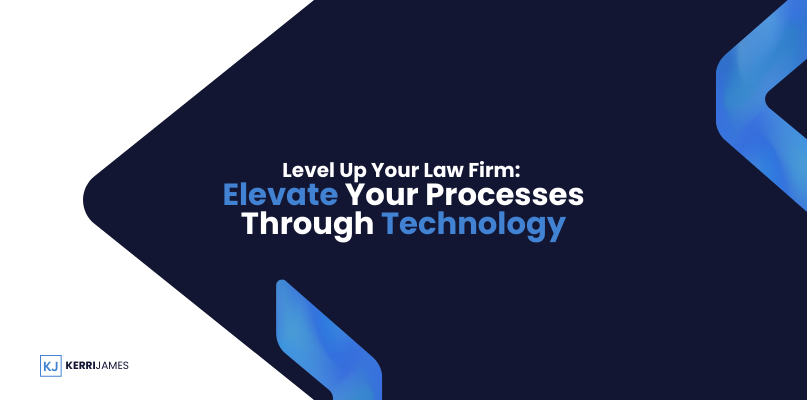Let’s face it: the image of a lawyer hunched over mountains of paperwork, fueled by caffeine and the faint hope of someday seeing the bottom of their inbox, is outdated.
Today’s legal landscape demands agility, efficiency, and a client-centric approach—and technology is the key to achieving all three.
This isn’t just about replacing pens with keyboards. It’s about leveraging powerful tools to streamline every aspect of your practice, from the moment a potential client lands on your website to the final resolution of their case (and every touchpoint in between).
This comprehensive guide will be your roadmap to transforming your law firm into a well-oiled, tech-powered machine. We’ll dive deep into the specific areas where technology can make a dramatic impact, exploring the tools, strategies, and best practices to elevate your firm to new heights of efficiency and client satisfaction.
Part 1: Streamlining Client Intake and Engagement
The client intake process is your firm’s first impression, a crucial moment that can make or break a potential client relationship. A clunky, time-consuming experience can send them running to your competitors, while a seamless, technology-driven approach establishes trust, professionalism, and efficiency from the get-go.
1.1. Online Intake Forms: The 24/7 Virtual Receptionist
Remember those tedious paper forms filled with redundant questions and illegible handwriting? Those days are over. Online intake forms, easily embedded on your website or shared via email, transform the way you capture essential client information.
- Benefits You’ll Love:
- 24/7 Accessibility: Potential clients can submit their information at any time, from anywhere, eliminating phone tag and accommodating busy schedules.
- Reduced Errors and Increased Accuracy: Automated data validation ensures consistent, error-free information, minimizing the risk of typos and inaccuracies that plague manual data entry.
- Seamless Integration: Leading intake forms integrate directly with practice management software, automatically populating client files and eliminating the need for manual data transfer.
- Enhanced Client Experience: A user-friendly online form provides a modern, convenient alternative to paper forms, making a positive impression from the first interaction.
1.2. Automated Appointment Scheduling: Say Goodbye to Calendar Chaos
Juggling phone calls, emails, and paper calendars to schedule client consultations is a recipe for frustration – for both you and your potential clients. Automated scheduling tools take the hassle out of appointment booking, freeing up valuable time and reducing no-shows.
- Benefits That Free Up Your Day (and Your Sanity):
- 24/7 Booking: Clients can schedule appointments based on your real-time availability, even outside of business hours.
- Elimination of Back-and-Forth Communication: Automated scheduling eliminates the need for endless emails or phone tag to find a mutually convenient time.
- Reduced No-Shows: Automated appointment reminders sent via email or text message significantly decrease no-show rates.
- Integration with Calendar and Practice Management Software: Appointments booked through scheduling tools automatically sync with your existing calendar system, providing a centralized view of your schedule.
1.3. Client Relationship Management (CRM) Systems: Building Relationships That Last
A CRM system is your secret weapon for managing client relationships like a pro. No more scattered spreadsheets, forgotten follow-ups, or missed opportunities.
- The Power of a Centralized Client Hub:
- Contact Management: Keep detailed records of client information, communication history, case notes, and more – all in one easily accessible location.
- Communication Tracking: Log every email, phone call, and meeting, providing a complete overview of all client interactions.
- Task Management and Reminders: Set reminders for follow-ups, deadlines, and other important client-related tasks, ensuring nothing falls through the cracks.
- Reporting and Analytics: Track key metrics like client intake sources, conversion rates, and client satisfaction to identify areas for improvement and measure the effectiveness of your client engagement strategies.
Part 2: Transforming Case Management and Legal Research
Gone are the days of towering file cabinets, lost documents, and endless hours scouring law libraries. Cloud-based case management software and AI-powered research tools streamline your workflow, improve organization, and ensure you have the information you need, precisely when you need it.
2.1. Cloud-Based Case Management: Your Virtual War Room
Cloud-based case management software provides a centralized hub for all your case-related information, accessible from anywhere with an internet connection.
- Your Digital Command Center:
- Document Management: Securely store, organize, and share documents with your team, clients, and opposing counsel.
- Task Management: Create and assign tasks, set deadlines, and track progress, ensuring everyone is on top of their responsibilities.
- Calendar Synchronization: Keep track of court dates, deadlines, and other critical events, syncing your case calendar with your personal calendar.
- Communication Tools: Communicate securely with clients, team members, and experts, logging all interactions within the case file.
- Automated Time Tracking and Billing: Integrate case management with billing systems for seamless time tracking, invoice creation, and payment processing.
2.2. AI-Powered Legal Research Tools: Research Smarter, Not Harder
Artificial intelligence is revolutionizing legal research, making it faster, more efficient, and more accurate than ever before.
- Benefits that Outpace Traditional Research:
- Natural Language Searching: Find relevant case law, statutes, and other legal documents using everyday language, without the need for complex Boolean searches.
- AI-Driven Analytics and Insights: Uncover hidden patterns, trends, and connections in legal data that traditional research methods might miss.
- Predictive Outcomes and Case Law Analysis: Some AI-powered tools use machine learning algorithms to analyze case law and provide insights into potential outcomes, helping you make informed decisions about litigation strategy.
Part 3: Optimizing Internal Operations and Collaboration
Internal processes often fall by the wayside as law firms prioritize client work. However, inefficient operations can hinder productivity and impact your bottom line. Technology provides the tools you need to streamline internal tasks, improve communication, and empower your team.
3.1. Task and Project Management: Taming the Chaos of To-Dos
Project management tools help law firms manage tasks, track deadlines, and improve team collaboration – all in one centralized location.
- Key Features to Keep Your Projects on Track:
- Task Creation and Assignment: Create and assign tasks to individual team members, set clear deadlines, and track progress in real time.
- Project Workspaces: Organize tasks by client, case, or project, providing a structured framework for collaboration.
- File Sharing and Communication: Share files, comments, and updates within the platform, keeping all project-related information centralized and accessible.
3.2. Collaboration and Communication Tools: Breaking Down Silos
Effective communication is the cornerstone of any successful law firm. From internal team collaboration to external client communication, technology offers a range of tools to keep everyone connected and on the same page.
- Essential Tools for Seamless Communication:
- Instant Messaging and Chat Platforms: Facilitate real-time communication within your team, replacing the inefficiency of internal emails for quick questions, updates, and file sharing.
- Video Conferencing Tools: Conduct virtual meetings with clients, team members, and experts, regardless of location.
- Cloud-Based File Sharing and Storage: Ensure everyone has access to the most up-to-date versions of documents, eliminating confusion and facilitating seamless collaboration.
Part 4: Leveraging Automation for Efficiency
Automation isn’t about replacing lawyers; it’s about empowering them to focus on high-value tasks by offloading repetitive, time-consuming processes to technology.
4.1. Document Automation: Say Goodbye to Tedious Drafting
Drafting routine legal documents can feel like Groundhog Day – the same clauses, the same formatting, the same endless editing. Document automation software brings an end to this soul-crushing cycle.
- Benefits You Can Take to the Bank:
- Reduced Drafting Time: Create templates for your most frequently used documents, auto-populating information from your case management system or client intake forms.
- Improved Accuracy and Consistency: Eliminate the risk of typos, omissions, and inconsistencies that plague manual drafting.
- Increased Efficiency and Productivity: Free up valuable time for your team to focus on more strategic tasks, such as client consultations, legal research, and court appearances.
4.2. Workflow Automation: Streamlining Processes for Maximum Impact
Think of workflow automation as a series of digital dominoes. By connecting different tasks and triggers, you can create automated sequences that streamline your processes from start to finish.
- Workflows That Work Harder, So You Don’t Have To:
- Automated Client Onboarding: Imagine this: a client signs an engagement letter. This triggers an automated sequence that creates a new case file in your case management system, generates a welcome email with essential information, and schedules an initial consultation – all without you lifting a finger.
- Automated Task Assignment: When a deadline is approaching, the relevant task is automatically assigned to the responsible team member, along with a reminder notification.
- Automated Document Delivery: Clients receive automated email notifications when documents are ready for review or signature, eliminating the need for manual emails or phone calls.
Part 5: Embracing a Culture of Technology and Innovation
Integrating technology into your law firm is an ongoing journey, not a one-time fix. To fully reap the benefits of a tech-powered practice, you need to foster a culture of learning, adaptability, and continuous improvement.
- Building a Culture That Embraces Change:
- Lead by Example: Embrace technology yourself, becoming proficient in the tools you implement and demonstrating their value to your team.
- Provide Comprehensive Training and Support: Don’t just hand your team new software and expect them to figure it out on their own. Offer hands-on training, create user-friendly documentation, and be available to answer questions and provide support.
- Encourage Experimentation and Feedback: Foster a culture where team members feel comfortable experimenting with new tools and providing feedback on ways to improve processes.
- Stay Ahead of the Curve: The legal technology landscape is constantly evolving. Attend industry events, read blogs and articles, and stay informed about emerging trends and innovations.
Technology: Your Law Firm’s Secret Weapon for Efficiency and Client Satisfaction
Integrating technology into your law firm isn’t just about keeping up with the times; it’s about working smarter, serving clients better, and building a thriving, sustainable practice. By embracing the power of automation, cloud-based solutions, and data-driven insights, you can unlock a level of efficiency, client-centricity, and strategic growth that was once unimaginable.
This isn’t the future of law—it’s the present. The time to level up your law firm through technology is now.










